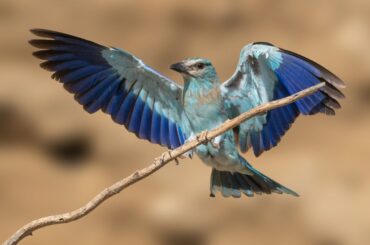Are you ready to embark on an avian adventure along the sandy shores of Florida? If you’re a bird watcher or enthusiast, get ready to be captivated by the vibrant world of Florida beach birds. With its diverse coastal habitats and the picturesque backdrop of the Florida Gulf Coast, this sunshine state becomes a haven for many fascinating bird species.
In this blog, we’ll take you on a virtual journey to discover 15 remarkable beach birds found in the enchanting realm of Florida, where nature’s beauty and avian wonders collide. So, grab your binoculars and join us as we explore the feathered inhabitants of Florida’s sandy beaches.
What Does a Beach Bird Look Like In Florida?
When it comes to the black and white birds of Florida Gulf Coast, certain similarities can be observed. Many of these birds are medium to large, showcasing a noticeable presence in the sky and along the shoreline. Their color palette is a contrasting tone of black and white, creating a striking display against the sandy beaches and sparkling ocean waves.
These birds possess sleek and streamlined bodies, enabling them to navigate the coastal winds with agility and precision. With their sharp beaks and keen eyesight, they are adept hunters, always looking for their next meal.
Let’s learn more about these Florida sea birds and uncover the secrets behind their striking appearance and captivating behaviors.
1. Brown Pelican

- Kingdom: Animalia
- Phylum: Chordata
- Class: Aves
- Order: Pelecaniformes
- Genus: Pelecanus
- Species: P. occidentalis
Brown Pelicans (Pelecanus occidentalis) are the iconic shore birds of Florida that possess unique characteristics. They scoop up fish precisely with their large wingspan and stretchy throat pouch. Their keen eyesight, streamlined bodies, and powerful wings enable them to glide effortlessly and dive into the water to catch prey.
These birds have adapted well to the coastal habitat with their unique air sacs that provide ample protection during their high-altitude dives in pursuit of their prey. During breeding, they form colonies on remote islands, ensuring the safety of their vulnerable chicks.
Brown Pelicans can be observed along the Gulf Coast and Atlantic Coast of Florida, perched on pylons or floating on water, showcasing their stunning aerial displays and nesting in crowded colonies. They have a long lifespan of up to 30 years.

2. Laughing Gull
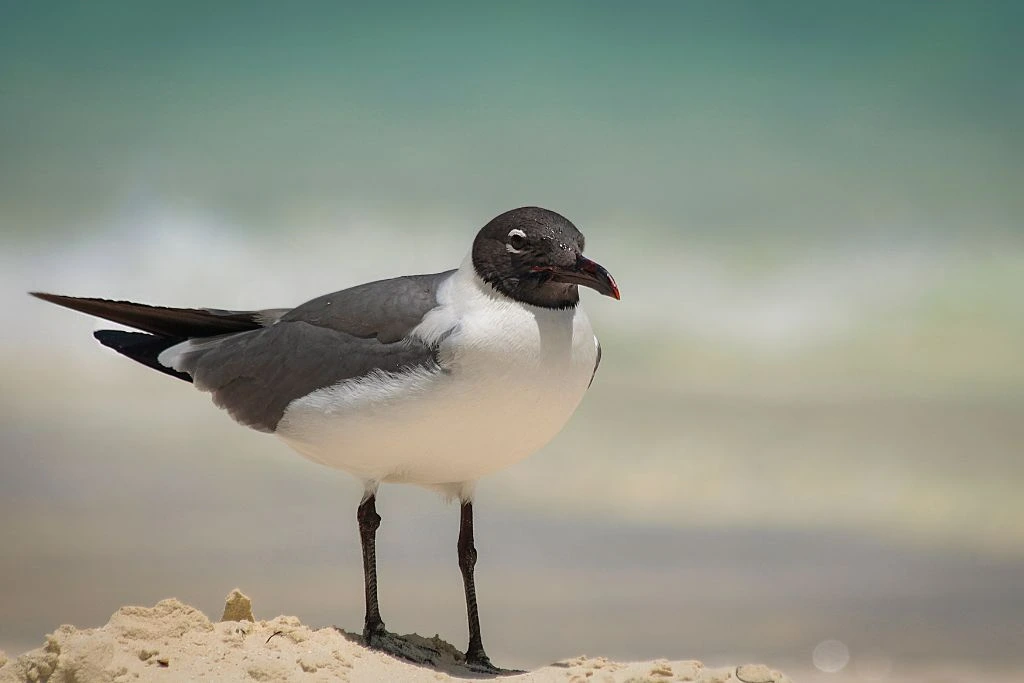
- Kingdom: Animalia
- Phylum: Chordata
- Class: Aves
- Order: Charadriiformes
- Genus: Leucophaeus
- Species: L. atricilla
The Laughing Gull (Leucophaeus atricilla) is a charismatic shorebird in Florida that boasts distinct features and a captivating presence, with medium-sized bodies, gray wings, and blackheads. During breeding, they create a charming contrast against the coastal backdrop. Their unique call, resembling a hearty laugh, adds a touch of whimsy to the atmosphere.
These birds have adapted to the coastal habitat with strong wings and agile flight, skillfully swooping and diving to catch fish and invertebrates. They are adaptable and can be found in coastal habitats, like beaches, marshes, and estuaries. They are skilled scavengers, taking advantage of human presence by feeding on scraps and discarded food.
Laughing Gulls gather in large colonies on coastal islands during breeding, creating a vibrant and noisy spectacle. They construct nests on the ground, forming bustling communities. Males court females through elegant flight displays and food offerings. Both parents care for the chicks, taking turns in protection and feeding.

3. Royal Tern

- Kingdom: Animalia
- Phylum: Chordata
- Class: Aves
- Order: Charadriiformes
- Genus: Thalasseus
- Species: T. maximum
The Royal Tern (Thalasseus maximus), a majestic bird along Florida’s shores, stands out with its regal presence and distinctive characteristics. They have sleek bodies, silver-gray wings, and orange bills. During breeding, their black crown adds magnificence to their appearance. These birds have also adapted to the coastal habitat with sharp, pointed bills for capturing fish.
When nesting, Royal Terns form their colonies on sandy beaches or coastal islands, constructing shallow nests. Males court females by offering gifts of fish, solidifying their bond. Both parents incubate the eggs and care for the chicks, ensuring protection and providing nourishment.
Royal Tern has a life expectancy of up to 20 years or more. They are mostly found along Florida’s coastline, from the Atlantic’s sandy beaches to the tranquil Gulf of Mexico shores. Royal Terns captivate with their aerial grace and vibrant nesting colonies, offering a majestic spectacle for bird enthusiasts and nature lovers.

4. Black Skimmer
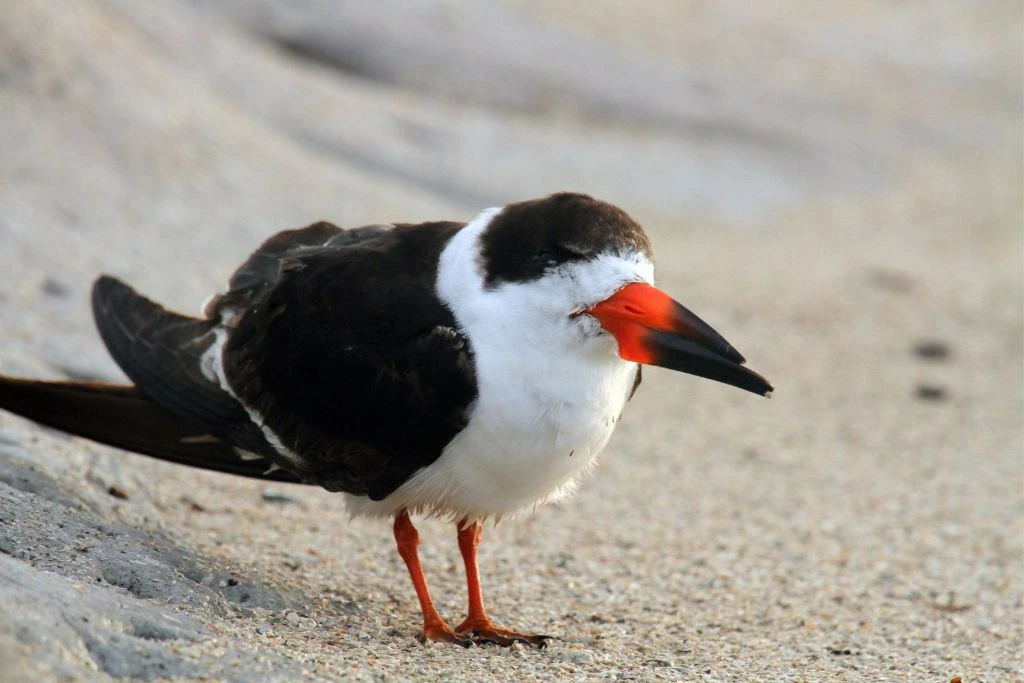
- Kingdom: Animalia
- Phylum: Chordata
- Class: Aves
- Order: Charadriiformes
- Genus: Rynchops
- Species: R. niger
Black Skimmer (Rynchops niger), a fascinating bird with unique physical and behavioral traits, is commonly found on the sandy beaches of Florida. It has striking black and white plumage, easily distinguishable from other birds. It also has a unique beak, much longer than its head, which helps it catch fish even in shallow water.
Black Skimmers breed in large colonies, with the males performing elaborate courtship displays to attract females. They lay their eggs on the sand, and both parents take turns incubating them. Interestingly, the chicks of Black Skimmers have black and white stripes that help them blend in with the sand.
The Migratory Bird Treaty Act ensures their safety in the wild, where they can thrive for up to a decade. In Florida, Black Skimmers can be spotted along the Gulf and Atlantic coasts, particularly on the sandy beaches of Sanibel Island, Sebastian Inlet, and Honeymoon Island State Park.

5. Wilson’s Plover

- Kingdom: Animalia
- Phylum: Chordata
- Class: Aves
- Order: Charadriiformes
- Genus: Charadrius
- Species: C. wilsonia
Wilson’s Plover (Charadrius wilsonia) is one of the small beach birds in Florida. This compact bird stands out in its coastal habitat with sandy-brown upper parts and a distinctive black band across its chest. It also has a short, stout bill, ideal for capturing crustaceans and small mollusks along the shoreline.
Male Wilson’s Plovers fiercely defend their nesting territories and perform courtship displays to attract females. They construct their nest with shallow scrapes in the sand, lining them with shells or pebbles. Keep an eye out for their fascinating “broken-wing” displays, which distract predators from their nests.
Did you know that Wilson’s Plover can live up to 10 years in the wild? To catch a glimpse of these captivating shorebirds, explore Florida’s coastal areas, such as Merritt Island National Wildlife Refuge, J.N. “Ding” Darling National Wildlife Refuge, and St. George Island State Park.

6. Sanderling

- Kingdom: Animalia
- Phylum: Chordata
- Class: Aves
- Order: Charadriiformes
- Genus: Calidris
- Species: C. alba
Sanderling (Calidris alba), or the “wave chaser,” are small wading birds found along the Florida coast. They have short black bills, white underparts, and reddish-brown backs during the breeding season. To survive in their coastal habitat, they have developed longer legs, enabling them to quickly run back and forth on the beach to catch their prey.
These birds typically nest in the Arctic Tundra during the summer months but migrate south to Florida and other coastal areas for the winter. They form large flocks and can often be seen scurrying along the beach for food. Interestingly, Sanderling has been known to run toward incoming waves and retreat quickly, hence the nickname “wave chaser.”
Sanderling has a lifespan of around 5 to 6 years in the wild. They are commonly spotted along the sandy beaches of Florida during the winter months. With their unique foraging techniques and fascinating behavior, Sanderlings are a beloved bird species among bird enthusiasts and beachgoers.

7. Least Tern
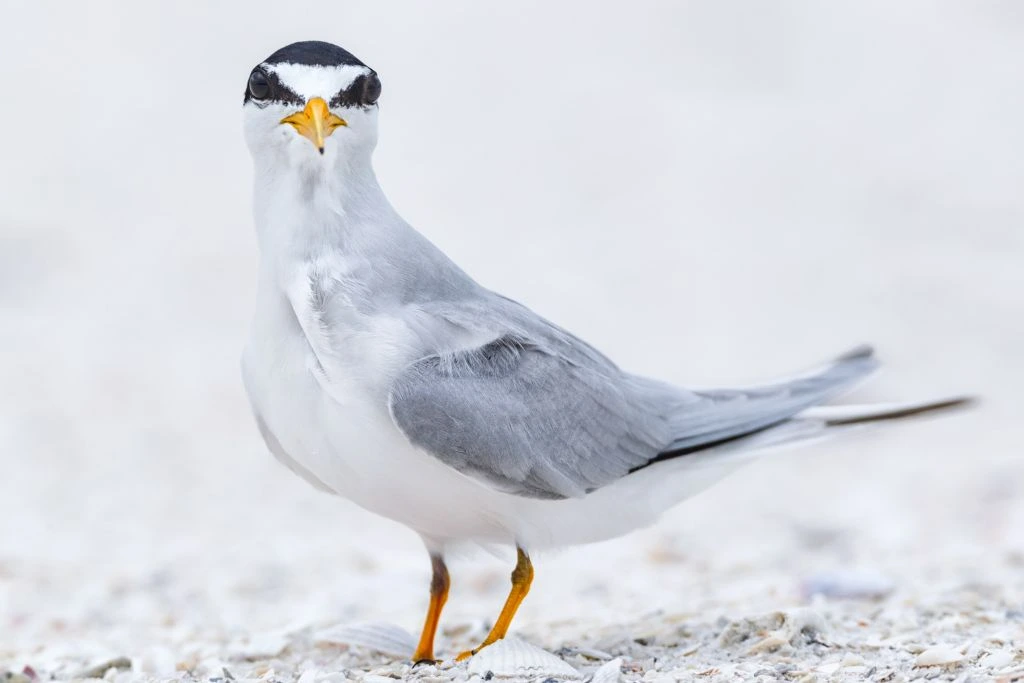
- Kingdom: Animalia
- Phylum: Chordata
- Class: Aves
- Order: Charadriiformes
- Genus: Sternula
- Species: S. antillarum
If you’re visiting the coastal areas of Florida, keep an eye out for the Least Tern (Sternula antillarum), the smallest tern in North America. With its striking black crown and white forehead, spotting this bird as it swoops and dives over the water is easy.
The Least Tern is specially adapted to its sandy coastal habitat, with its small size allowing it to forage for tiny fish and invertebrates in the shallow water along the shore. It nests on the ground, laying its eggs on sandy beaches or other open areas near the water.
During the breeding season, you might see the Least Tern performing an aerial courtship display, where the male offers a fish to the female while in flight. Although their normal wild lifespan is only four years, these birds can produce several broods of eggs a year. You can look for them on sandy beaches and inlets along the Florida coast!

8. Willet

- Kingdom: Animalia
- Phylum: Chordata
- Class: Aves
- Order: Charadriiformes
- Genus: Tringa
- Species: T. semipalmata
The Willet (Tringa semipalmata) is a distinctive bird with its long, thick bill and sturdy build. It is well adapted to its coastal habitat and can often be seen wading along the shoreline and in shallow waterways, probing the sand for food. Look for this remarkable bird as it explores the sandy beaches and marshy areas of Florida’s coast.
When it comes to nesting, the Willet constructs its nest in a shallow depression in the sand. During the breeding season, the males perform impressive aerial displays, showcasing their courtship skills to attract a mate. With an average lifespan of up to 15 years in the wild, the Willet demonstrates its commitment to nesting and raising its young.
An intriguing fact about the Willet is its unique behavior known as “foot-stamping.” This behavior involves the bird rapidly tapping its feet on the ground, potentially to flush out hidden prey from the sand. Willets can be found year-round in Florida, with larger populations present during winter.

9. Reddish Egret

- Kingdom: Animalia
- Phylum: Chordata
- Class: Aves
- Order: Pelecaniformes
- Genus: Egretta
- Species: E. rufescens
The Reddish Egret (Egretta rufescens) is a striking bird known for its shaggy, rusty-colored feathers. Its long, thin legs are perfect for wading in shallow water while searching for food, and its sharp bill is used to spear small fish. You’ll recognize this bird by its unique feeding behavior of running, jumping, and flapping its wings to stir up fish.
Reddish Egrets are found in coastal areas, where they nest and roost in spaces with tall vegetation. These birds are also known for their adaptability, as they are one of the few species of egrets that hunt in both saltwater and freshwater environments. This bird species is also known to be quite vocal, communicating with each other through various calls and displays.
Reddish Egrets are monogamous, forming pairs during the breeding season. The male builds a platform nest out of sticks, twigs, and vegetation, while the female incubates the eggs. The chicks are born with white downy feathers, and both parents care for them until they are ready to fledge. Interestingly, the Reddish Egret has a lifespan of around 15 years in the wild and is listed as a species of Least Concern due to its large population size.

10. Snowy Egret

- Kingdom: Animalia
- Phylum: Chordata
- Class: Aves
- Order: Pelecaniformes
- Genus: Egretta
- Species: E. thula
Snowy Egrets (Egretta thula) are fascinating birds found in Florida’s wetlands. They are easily recognized by their white feathers, black legs, and bright yellow feet. These birds can grow to a maximum of 2 feet in height and 3 feet in width. During the breeding season, they grow delicate plumes on their back for courtship displays.
Adapted to wetland environments, Snowy Egrets have long legs and sharp beaks, making them skilled hunters. They feed on fish, insects, and other small prey. They can be found in various habitats, from saltwater marshes to freshwater ponds. Snowy Egrets often hunt in groups, using their sharp eyesight and agility.
Snowy Egrets exhibit interesting nesting behaviors. They form lifelong pairs and build their nests in trees or shrubs near the water. During the breeding season, they engage in elaborate courtship displays, including aerial acrobatics and bill snapping. Both parents are responsible for incubating the eggs and feeding the chicks until they fledge at approximately three weeks old.
These magnificent birds have a lifespan of up to 17 years in the wild. An intriguing fact about Snowy Egrets is their historical association with the fashion industry, as they were once hunted for their plumes. However, conservation efforts have helped their population recover. You can spot them in Florida’s coastal areas and wetlands, particularly in the Everglades, Merritt Island National Wildlife Refuge, and Ding Darling National Wildlife Refuge.

11. Great Blue Heron

- Kingdom: Animalia
- Phylum: Chordata
- Class: Aves
- Order: Pelecaniformes
- Genus: Ardea
- Species: A. herodias
The Great Blue Heron (Ardea herodias) is a majestic bird commonly found in Florida. It stands tall, reaching up to 4 feet, with a wingspan of approximately 6 feet. With its long neck and sharp bill, this heron possesses the perfect tools for capturing prey during hunting expeditions.
Adapted to diverse environments, the Great Blue Heron is a versatile hunter. It navigates various habitats, including freshwater marshes, swamps, and coastal areas. With its long legs and slender physique, it can move easily and stealthily. Keep an eye out for its patient stance along the water’s edge, ready to spearfish amphibians and even small mammals.
During the breeding season, they gather in heronries, establishing their homes in tall trees or shrubs near bodies of water. They construct large nests using sticks and vegetation. It’s interesting to note that they exhibit monogamy during breeding but may form new partnerships in subsequent years.
The Great Blue Heron has an impressive lifespan of up to 15 years in the wild. They can be spotted along Florida’s coastlines, estuaries, mangroves, wetlands, and parks. Keep a lookout for their patient stalking and graceful flight as they move through their natural habitats with elegance and purpose.

12. Great Egret

- Kingdom: Animalia
- Phylum: Chordata
- Class: Aves
- Order: Pelecaniformes
- Genus: Ardea
- Species: A. alba
The Great Egret (Ardea alba) can be easily identified by its long, S-shaped neck, white plumage, and yellow bill. The Great Egret is the tallest and widest of the North American egrets, with a maximum height of 3.3 feet and a wingspan of 4.5 feet. Its long, sharp bill helps it catch its prey, like fish, frogs, and small mammals. Great Egrets can be found in various wetland habitats, including marshes, swamps, ponds, and lakes.
When it’s breeding season, Great Egrets perform elaborate courtship displays, including bill-touching, head-turning, and feather-raising. They build their nests in trees or bushes near water, and males and females take turns incubating the eggs and feeding the young. Great Egrets have a maximum wildlife expectancy of 15 years, although this is greatly reduced by threats, such as habitat loss, pollution, and predation.
An interesting fact about the Great Egret is that their white feathers were once highly sought after for use in hats, resulting in a drastic decline in their population during the early 20th century. However, conservation efforts helped bring their numbers back up, and they are now a common sight in wetland habitats across the world.
If you’re in Florida, you’re likely to spot them in freshwater or brackish wetlands, such as the Everglades, where they are often seen wading in the shallow water.
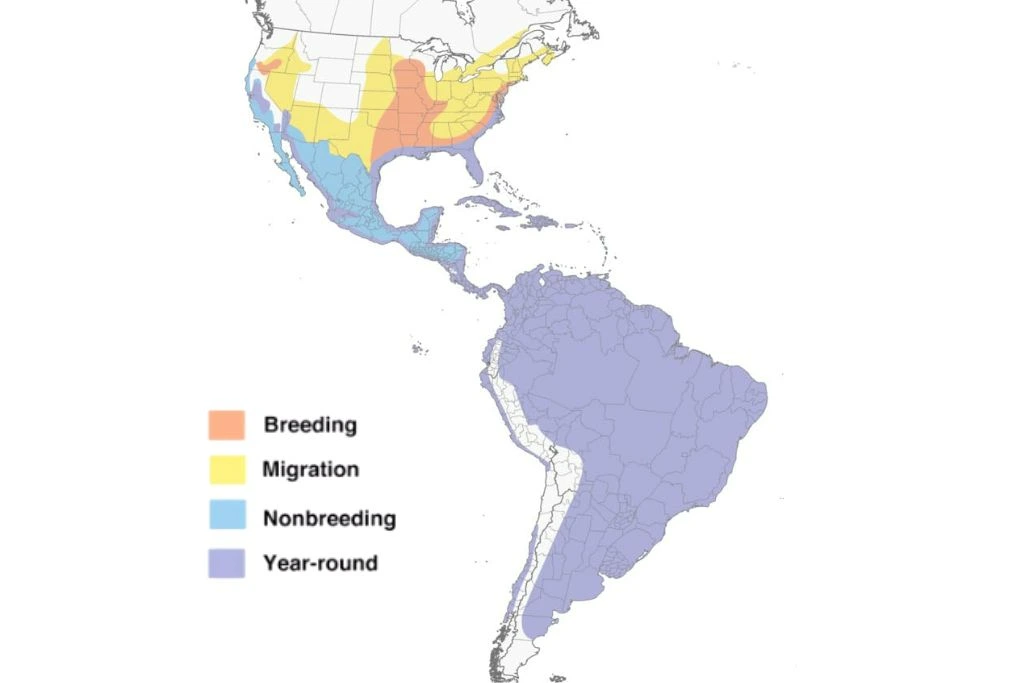
13. Little Blue Heron

- Kingdom: Animalia
- Phylum: Chordata
- Class: Aves
- Order: Pelecaniformes
- Genus: Egretta
- Species: E. caerulea
The Little Blue Heron (Egretta aerulea) is a captivating bird that you can easily recognize by its striking blue-gray plumage and slender build. It is a medium-sized heron, standing around 2 feet tall, with a wingspan of about 3.5 feet. Its thin, curved bill is uniquely adapted for capturing small fish, amphibians, and invertebrates, making it a skilled hunter in wetland habitats.
When it comes to nesting and breeding behaviors, the Little Blue Heron typically forms colonies with other herons and waterbirds. They build their nests in trees or shrubs near water, providing a haven for their young.
During the breeding season, adult Little Blue Herons develop beautiful plumes on their heads, necks, and backs. These plumes are used in courtship displays to attract mates. As for their life expectancy, Little Blue Herons can live up to 10 years in the wild, but their lifespan can be influenced by factors that include habitat quality and availability of food.
Did you know that the Little Blue Heron undergoes a fascinating color transformation as it matures? Juvenile birds are predominantly white, gradually transitioning to their characteristic blue-gray plumage as they reach adulthood. This unique transformation sets them apart from other heron species.

14. Tricolored Heron

- Kingdom: Animalia
- Phylum: Chordata
- Class: Aves
- Order: Pelecaniformes
- Genus: Egretta
- Species: E. tricolor
The Tricolored Heron (Egretta tricolor) is a slender bird with a distinctive blue-gray color, a white belly, and a rust-colored neck. It is easily distinguished by its long, yellowish-green legs and its long, slender neck, which it frequently holds in a S shape. Its long, thin, and pointed bill makes it an effective tool for catching fish and other small prey.
These birds are commonly found in freshwater and saltwater habitats throughout Florida. It can often be seen wading in shallow water, using its long legs to search for food. Its adaptations include a special third eyelid that allows it to see underwater without getting its eyes wet and a long, sharp bill that it uses to catch fish, shrimp, and other small creatures.
During the breeding season, the Tricolored Heron’s plumage changes to a deep maroon color, and it develops long, lacy feathers on its back. It typically nests in colonies with other wading birds and constructs its nest in trees or shrubs near water. Interestingly, Tricolored Herons often engage in “false displays” during courtship, performing exaggerated movements to impress potential mates.
Did you know that Tricolored Heron employs a unique hunting strategy called “canopy feeding?” Unlike many other heron species that hunt by wading in shallow water, the Tricolored Heron can be seen using its wings as a canopy, creating shade over the water. This clever tactic attracts fish seeking shelter from the sun and makes them more vulnerable to the heron’s swift strikes.

<h2>15. Black-Crowned Night Heron

- Kingdom: Animalia
- Phylum: Chordata
- Class: Aves
- Order: Pelecaniformes
- Genus: Nycticorax
- Species: N. nycticorax
When you encounter the Black-Crowned Night Heron (Nycticorax nycticorax), you’ll notice its distinctive appearance. This medium-sized heron boasts a black crown and back, gray wings and belly, and striking red eyes. Its short, sturdy legs and thick bill are well-suited for its hunting style, which often involves patiently waiting and striking swiftly at its prey.
This adaptable heron can be found in various habitats, including marshes, wetlands, and wooded areas near water. Its nocturnal nature makes it well-equipped for hunting during the nighttime hours. With excellent night vision and keen hearing, it can skillfully locate and capture fish, amphibians, insects, and even small mammals.
During the nesting season, the Black-Crowned Night Heron forms breeding colonies, building its nest in trees or shrubs near water. These nests are often constructed from sticks and lined with softer materials.
An interesting fact about this bird is that it’s known to engage in a behavior called “bill-clattering” during courtship, where it rapidly snaps its bill together, producing a distinct sound. You can spot the Black-crowned Night Heron in various coastal and freshwater habitats in Florida.

FAQs
How can I identify beach birds in Florida?
Pay attention to features like plumage patterns, bill length, leg color, and distinctive behaviors like feeding or flying patterns. Field guides or birding apps specific to Florida can be helpful in identifying the different species.
Are beach birds in Florida migratory or year-round residents?
Both migratory and year-round resident beach bird species can be found in Florida. Some species, like the Snowy Plover and Least Tern, are migratory and visit Florida during their breeding season. Others, such as the Black Skimmer and Brown Pelican, are year-round residents.
Can I feed beach birds in Florida?
It is generally discouraged to feed beach birds in Florida. Feeding wildlife can disrupt their natural feeding habits. It may cause them to become dependent on human food, which can be detrimental to their health.





